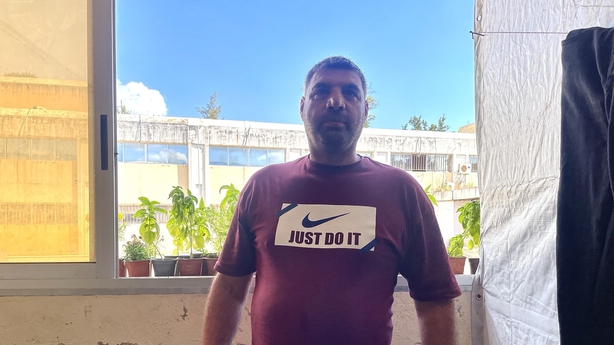Even as a school, Tyre Vocational and Technical school would be considered dilapidated. The paint on the walls is peeling, the bathrooms are basic. There is no air conditioning.
As a shelter, it is far from ideal. Its classrooms are a poor substitute for what the families staying there have left behind.
Twelve-year-old Aya said she is not happy in the shelter, that she wants to play with her own toys, in her own home.
A set of plastic garden chairs and a teacher's desk are the only pieces of furniture in the tiny classroom where they now live.
We need your consent to load this rte-player contentWe use rte-player to manage extra content that can set cookies on your device and collect data about your activity. Please review their details and accept them to load the content.Manage Preferences
Across the length of one wall, they have hung their washing to dry. Pots and pans are stacked on a ramshackle trolley.
In one corner, they have piled their bedding high - pillows and duvets, makeshift mattresses and sheets.
Her father, Ali, told RTÉ News that she understands why this has happened. But Aya still wants to go home.
Lebanese militant group Hezbollah has been exchanging rocket fire with Israel almost since the 7 October Hamas attack.
On either side of the border, tens of thousands have been displaced.
Aya and Ali are among 100,000 people who have fled towns and villages in Lebanon’s southernmost areas.

The shelter in Tyre is one of five in the city. It houses around 250 people, 70 of whom are children like Aya.
"What is happening in Gaza is absolutely tragic, but it is unfortunately having broader geopolitical and regional consequences here in the Middle East," Peter Power, the Executive Director of UNICEF Ireland, said.
"Here now in Lebanon today, I have met children who have been forced to flee from southern Lebanon," he said.
Among the 70 children at this shelter is an 18-month-old girl.
Her mother, Farah, said that she and her husband did not make the decision to leave their home lightly.
She is not happy here either, she said.
"They do not have a context for what is happening"
But they did it for the safety of her children, so they would not have to hear the sounds of missiles and bombs.
"It is a little bit overwhelming for kids, and especially because they do not know – or they do not have a context for what is happening," Sami Al Khoury, a co-ordinator with Save the Children, which runs programmes in the shelters in Tyre, said.
Though safer than the areas closest to the border, Tyre is still on the edge of the danger zone.
Two days ago, planes flew over the shelter, Farah said.
Nearly eight months after they left their homes, she had to reassure her children that they were going to be OK.
The cross-border hostilities between Hezbollah and Israel are the worst since the 2006 Lebanon war. That was a full-scale conflict that upended much of Lebanon. But it was also over in 34 days.
Read more: Why conflict with Israel is the last thing Lebanon needs
Many of the families at the shelter in Tyre thought that they would be away from home for days if not weeks.
But, as Israel continues its assault on Rafah, there is no end in sight, no indication of when they will be able to return home.
"It is a dramatic escalation. Schools have been targeted, health facilities have been targeted. A UNICEF water-pumping station has been targeted, and even agricultural land has been bombed with phosphorus bombs," Mr Power said.
"And this has displaced over 100,000 people now who urgently need humanitarian assistance. And that's what we are here to do."






